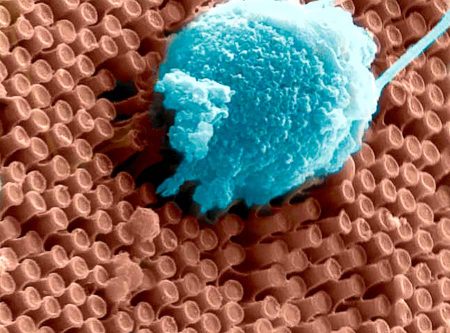March 17, 2017 – Nanovision Biosciences, a San Diego and La Jolla startup spun out of University of California San Diego (UCSD), has invented a high-resolution retinal implant that restores neurons in the eye to see light. A paper in the Journal of Neural Engineering entitled, “Towards high-resolution retinal prostheses with direct optical addressing and inductive telemetry,” describes the architecture of the implant and initial laboratory results using rat studies.
This device consists of a high-density electrode array with ultra-high photosensitive silicon nanowires. A single wireless telemetry and power link is the external controller for the implant. Its silicon nanowires “simultaneously sense light and electrically stimulate the retina,” reports Ioana Patringenaru of the UCSD News Center in a March 13th release. She quotes Gabriel Silva, Professor of Bioengineering and Ophthalmology, and one of the senior authors of the paper who states, “we want to create a new class of devices with drastically improved capabilities to help people with impaired vision.”
There are a number of unique features to this invention not seen in other retinal prostheses.
For example, there is no requirement for an external vision sensor to capture images and transform them into signals that can then be translated into recognized stimuli by retinal neurons. The Nanovision device instead, directly stimulates retinal cells by mimicking the eye’s natural light-sensing rods and cones.
Also, power comes from a wireless link that is highly energy efficient. In the UCSD press release, it describes how wireless power and data transmission achieves up to 90% efficiency in terms of energy transmitted and used for achieving vision. There is very little waste energy and heat that could affect surrounding body tissue.
In the image seen below the implant’s nanowires can be seen interfacing with cortical neurons to form a visual communication network.

Nanovision Biosciences, founded by two of the engineers from UCSD, intends to take the implant it has developed and refine it for use in human patients suffering from progressive disorders leading to blindness. The device would be surgically implantable within the subretinal space where photoreceptors normally reside. Because the recipient’s own photoreceptors have degenerated, there should be ample space for the implant.
Who can use the Nanovision technology?
Those suffering from retinal disorders such as macular degeneration (MD) and retinitis pigmentosa (RP), both leading causes of blindness. In western countries these two are the leading contributors to blindness.
Age-related MD cases in the United States totaled over 2 million in 2010 and are expected to grow to 5.4 million by 2050 according to the National Eye Institute. But MD isn’t just an old age disease. It can hit as early as the late teens leading to an individual becoming entirely blind within 20 years.

RP is an inherited disorder affecting 1 in 4,000 globally. Its cause — changes to up to 50 genes responsible for making the proteins needed by photoreceptor cells in the retina. Some of these mutations are toxic to photoreceptors affecting rods initially which leads to night blindness. Later the cones die leading to tunnel vision with a progressively narrower field of view.








